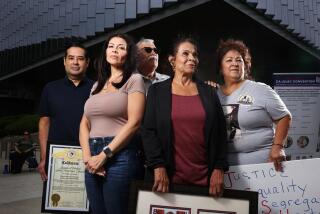School’s Out Forever
- Share via
For Enrique “Kiki” Zuniga, elementary school meant Army barracks for classrooms and a dirt courtyard for a playground.
“It felt almost like a detention camp, where you just went through the motions of school,” said Zuniga, 60, as he reflected on his childhood. “Nobody ever had any expectations of getting a job or anything.”
Zuniga and other Mexican Americans who grew up in La Habra between 1920 and 1950 are celebrating the 50th anniversary this year of the closure of Wilson Grammar School, where Latino children were forced to go for an education instead of joining white students at other schools.
And they mean celebrate. None of these alumni was sorry to see their school go.
Known as “‘the Mexican school,” Wilson opened in 1920 to school the children of farm workers who lived in the city’s migrant labor camps and picked fruit to earn a living.
“The school was built by the La Habra Citrus Assn. to teach children and adults new to the United States English,” said Esther Cramer, the city’s historian. “At least that was the initial intent, but the school stayed around much longer than it should have.”
Thirty years too long, some say.
“The language difference was really just an excuse,” Zuniga said. “By the time I was there in the 1940s, we were all Mexican Americans and many already knew English. There was a black family at the school and some American Indians, none of [whom] spoke Spanish, so it was really just for segregation.”
Teachers at Wilson punished students caught speaking Spanish.
“I remember being whipped with a rubber hose in fifth grade for speaking Spanish,” said 60-year-old Ray Molina, the president of the Wilson alumni group. “The teachers were really strict about it.”
At the time Wilson was built, the city also opened Lincoln Grammar School across town on the white side of La Habra, said 67-year-old Alfredo Zuniga, Enrique’s older brother.
“The city passed a $90,000 school bond to pay for the two schools,” he said. “Only $15,000 went for Wilson, the rest was for Lincoln.”
Compared with Wilson school, Lincoln overflowed with comfort, Alfredo Zuniga said. It was three stories high and built of brick with beautiful landscaping and grass.
“There were tennis courts and a concrete playground, an auditorium and buses for the students there, none of which were provided for Wilson,” Enrique Zuniga added.
Meanwhile, Wilson students played basketball on a dirt playground where the ball would barely bounce and whose hoops had no nets, Enrique Zuniga said.
Segregation covered all aspects of living in La Habra, Wilson alumni said. Mexican Americans lived on the south side of the city, literally on one side of the railroad tracks.
“When we went to the movies, Mexicans had to sit on the left side of the theater, where the seats were torn,” said 72-year-old Jesse Gomez. “Except on Tuesdays, when they showed the Spanish films. Then we all went and bragged about the nice seats to our friends, even though we couldn’t see anything because the farm workers wore their hats.”
Most of the students also worked alongside their parents in the citrus groves, picking oranges and lemons for local farm owners when the fruits were in season.
At Wilson, elementary teachers often wrote off Alfredo Zuniga as a lost cause because he missed months of school at a time following the fruit seasons around California.
He later went on to receive two master’s degrees from Cal State Fullerton and to manage the Anthony Quinn Library in East Los Angeles.
“I sure showed them,” he said.
In 1950, Cecil Brower, then the superintendent of La Habra School District, succeeded in closing Wilson and desegregating the city’s school system despite the school board’s opposition.
“He really saw the writing on the wall,” said Candelario Mendoza, a former Wilson teacher and the first Mexican American to teach in La Habra. “There were laws being passed about segregation, and he knew it had to be a thing of the past.”
A park and condominiums were built over the school site.
Now, the Wilson alumni are looking to the future.
Earlier this month, a group of them met to plan a summer reunion for 600 of their schoolmates and families, the fifth of its kind to celebrate their past and catch up on old times.
“I think it’s the fact that we were segregated that gives us a lot of pride,” Molina said, adding that many of his classmates have remained in La Habra. “My parents went to Wilson, I went to Wilson and we all grew up together.”
More to Read
Sign up for Essential California
The most important California stories and recommendations in your inbox every morning.
You may occasionally receive promotional content from the Los Angeles Times.










